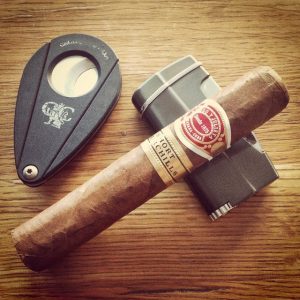INTRODUCTION
Quick Navigation
Cigar plume, also known as cigar bloom is a sign that the cigar is ageing properly and that the oils from the tobacco are starting to crystalise. The tobacco oils begin to evolve from inside and then crystallises at the surface. Most cigar enthusiasts believe that cigar plume is a natural process that occurs during the maturing stage of a stogie.
As the oil that has been caged in your cigar finishes crystallising, you may notice some whitish/grey spots that resemble a tiny spider web on your cigar. It may have all the signs of a cigar mould, but most cigar lovers claim that is crystalised sugars that contribute to the flavour of the cigar. It may sound shocking, but apparently, the sign of powdery cigars is meant to be a good sign of a successful ageing process. Most cigar lovers desire a cigar with a plume on it.
CIGAR MOLD AND CIGAR PLUME
Cigar bloom or prume and cigar mold are quite similar but not the same. Most cigar manufacturers or cigar smokers claim that cigar mold is more blue-ish/greenish while the cigar plume is more powder-like and whitish in its appearance. Also, it is said that plume is quite flat while the mold is said to be three-dimensional. However, there isn’t any scientific backing to these claims as cigar mold is usually white and powder-like too.
Cigar molds are usually aerobic fungi, mostly found in environments that are rich in oxygen. The mold spreads through the air and usually goes for areas with sugar for it to feed off on, depending on the specific type of mold. Having mold on your stogie shouldn’t be overlooked. It may come in various colours and grows way faster than a cigar plume does and it is also quite hairy.
Cigar mold can be caused by too much humidity in your humidor, remember to monitor your humidor and control it regularly to prevent cigar molds. If the humidity goes above 80%, you can expect the appearance of mold. To avoid this, you’d need to air your cigars frequently and make sure they don’t get over-humidified. Keeping the humidity below 70% isn’t even a guarantee that you wouldn’t have mold problems, but it reduces the risk of the build-up of mold. Molds can be caused by moisture, heat, organic material and so on. Cigars don’t expire; however, they are still prone to mold infections. Molds can infect the inside of your cigar and the surface too, It has a texture that feels velvety, or like moss and it also produces a damp odour.
Usage of non-distilled water in your humidification system can also bring about cigar mold. Smoking a moldy cigar is not advisable. It includes various bacteria and fungi, like a pathogen, aspergillus, penicillium. These bacteria can cause infections and sepsis.
Thankfully, you can use a clean cloth to wipe off the plume on your cigar and light it up for smoking. However, if you find mold on your cigar, it has most likely infiltrated your cigar and its best to dispose of it. If the cigar plume doesn’t bother you, you can use a cigar cutter to trim off the infected part of the cigar.
Cigar mold, on the other hand, is rather unsafe for human consumption. Once you notice the cigar mold, you will need to remove the infected cigars from the humidor and away from the unaffected ones so that they don’t contaminate the unaffected stogies. Another way to avoid having a mold problem is by purchasing your cigars from a reputable source to avoid purchasing old and already moldy cigar. Getting your cigars from an unknown source isn’t advisable as the cigars may have already been exposed to moisture or moldy environment and may end up transferring the mold to your stockpile and humidor.
EFFECTS OF CIGAR MOLD
It is definitely unhealthy to inhale and smoke cigars that have been infected with mold as you’ll end up inhaling mold spores, and this could land you in the hospital. Even mold removal experts have to wear a complete safety kit before removing mold from a household. It is quite dangerous to inhale mold spores, and it is not advisable to do so.
Apart from inhaling mold spores, it can also be absorbed by the skin, but the inhalation is worse. It can cause more damage to your health, depending on the strength of your immune system, the kind of mold and the parts of your body where the spores may settle in after making its way from the respiratory system. It can cause sickness, irritation of the skin and eye, nasal stuffiness, wheezing and so on.
It is best to get rid of mold or moldy cigars to be on the safe side.
PREVENTING CIGAR PLUME
Cigar molds tend to thrive in areas with a relatively high level of humidity beyond 70% RH. When there is too much moisture in your humidor, it’ll result in plume/mold breakouts. You can prevent cigar molds by;
- investing in a digital hygrometer will help to ensure that you’re cigars are stored at an excellent humidity level. These hygrometers are more accurate and precise than analogue hygrometers
.
- Ensure that you only use distilled water or propyl glycol solution for the reservoir of your humidor. Tap water or bottled water could cause a big problem for your cigars, but distilled water reduces the risk of mold growth in your cigars or humidor
.
- Remember to rotate your cigars frequently, like every week or every two weeks to avoid leaving the same cigars lay against each other on the humidification system. Also, remember to leave a fair amount of space to allow for a free flow of air in the humidor.
CONCLUSION
You can wipe your humidor with alcohol(isopropyl) and re-humidify the box for an extended period(after taking out the cigars). This will keep the mold at bay for a while. You can do this with your humidor before putting a fresh batch of cigars in it to avoid contamination.
cigar etiquette and traditions

